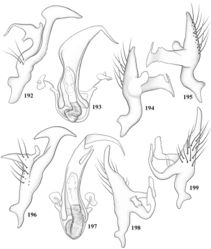Ceratocapsidea taeniola
| Notice: | This page is derived from the original publication listed below, whose author(s) should always be credited. Further contributors may edit and improve the content of this page and, consequently, need to be credited as well (see page history). Any assessment of factual correctness requires a careful review of the original article as well as of subsequent contributions.
If you are uncertain whether your planned contribution is correct or not, we suggest that you use the associated discussion page instead of editing the page directly. This page should be cited as follows (rationale):
Citation formats to copy and paste
BibTeX: @article{Henry2015ZooKeys, RIS/ Endnote: TY - JOUR Wikipedia/ Citizendium: <ref name="Henry2015ZooKeys">{{Citation See also the citation download page at the journal. |
Ordo: Hemiptera
Familia: Miridae
Genus: Ceratocapsidea
Name
Ceratocapsidea taeniola Henry sp. n. – Wikispecies link – ZooBank link – Pensoft Profile
Diagnosis
This species (Fig. 44) is distinguished by the overall dark brown to fuscous coloration, pale brown antennae, distally dark brown hind femora, and male genitalia, especially the apically trifid phallotheca (Fig. 197) with a long, broad, ribbon-like apical process and two shorter, parallel processes below and right paramere (Figs 198, 199) with two upturned arms.
Description
Male (n = 2; holotype measurements in parentheses): Length 3.64 mm (3.46 mm), length 1.32 mm (1.20 mm). Head: Width 0.73 mm (0.74 mm), interocular width 0.23 mm (0.24 mm). Labium: Length 1.31 mm (1.39 mm). Antenna: Segment I, length 0.33 mm (0.31 mm); II, 0.94 mm (0.88 mm); III 0.53 mm (0.51 mm); IV, 0.47 mm (0.44 mm). Pronotum: Lenght 0.73 mm (0.72 mm); basal width 1.25 mm (1.17 mm).
Coloration: Overall coloration dark brown to fuscous or almost black. Head: Fuscous, paler laterally below antennal bases. Labium: Uniformly brown. Antenna: Segments I and II brown; segment III and IV dark brown to fuscous. Pronotum: Uniformly shiny fuscous, collar slightly paler brown; scutellum fuscous, paler brown on apical third. Hemelytron: Uniformly, shiny dark brown, costal or emboliar margin and cuneus darker brown or fuscous; membrane uniformly translucent brown. Ventral surface: Shiny dark brown, becoming darker or fuscous laterally and distally on abdomen. Ostiolar evaporative area: Pale brown, central knob of auricle slightly darker. Leg: Coxae pale or whitish; fore and middle femora pale or white, with distal third tinged with brown, hind femur pale or whitish on basal half, dark brown on distal half; tibia, tarsi, and claws brown.
Structure, texture, and vestiture: Head: Finely granulate, becoming somewhat wrinkled on frons; with scattered, short, recumbent, simple setae on vertex and frons, and several long, erect setae at base of vertex. Labium: Extending beyond hind coxae to abdominal segment I or II. Pronotum: Disk shiny, with evenly distributed punctures; calli finely granulate, becoming finely wrinkled between and anteriorly. Scutellum: Evenly punctate, finely, transversely rugose; thickly set with relatively short, recumbent and semierect simple setae, intermixed with long, reclining, almost bristle-like setae. Hemelytron: Shiny, evenly and densely punctate, densely set with silvery, scale-like setae, intermixed with long, nearly erect, weakly curved, bristle-like setae.
Male genitalia: Left paramere (Fig. 196) slender, with a well-developed, beak-like distal process coming to a point at each end and a stout apically acute middle process, with a short, slender dorsally directed tubercle arising at base. Right paramere (Figs 198, 199) relatively stout, with two upturned, apically crenulate arms. Phallotheca (Fig. 197) evenly slender to trifid apex, ending in a long, apically acute, ribbon-like process and two shorter, more slender, nearly parallel processes just below.
Female: Unknown.
Etymology
The specific epithet taeniola is taken from the Latin “taenia”, meaning ribbon, and the diminutive suffix “ola”, in reference to the small ribbon-like apex of the phallotheca (Fig. 197).
Host
Unknown.
Distribution
Known only from Jamaica.
Type material
Holotype ♂: JAMAICA: St. Andrew Parish: Holywell Forest Camp, 1219 m, 11 Aug 1971, M. Winegar (00286276) (USNM). Paratype: JAMAICA: St. Andrew Parish: Holywell Forest Camp, 1219 m, Sep 1971 - Oct 1971, M. Winegar, 1♂ (00286275) (USNM).
Original Description
- Henry, T; 2015: Revision of the Ceratocapsine Renodaeus group: Marinonicoris, Pilophoropsis, Renodaeus, and Zanchisme, with descriptions of four new genera (Heteroptera, Miridae, Orthotylinae) ZooKeys, (490): 1-156. doi
Images
|

